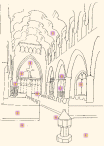Home

|
Home |
 |

Click to go to the Church Diagram 
Click to go to the Church View |
This site takes visitors on a tour of a 15th-century parish
church as Margery Kempe might have seen it. Through her Book
she identifies dozens of churches, many still extant, by name. Always
attentive to the implications of locations, she also frequently mentions
the precise part of a church in which in which an experience took place
- the chancel, a particular chapel, the high altar, etc. One might
say that Kempe maps her life onto the floorplan of the church. Click here
for general study topics and seminar
projects that examine Kempe and the material culture of the parish.
Although many English parish churches in Norfolk and Suffolk counties
retained considerable medieval integrity, all have suffered from destruction
over the years, the most evident loss being wall paintings and original
stained glass. St. Margaret's in King's
Lynn, for example, has been radically altered from the time of Margery
Kempe- the entire nave now dates from the 18th century, the transepts have
been shortened, the altar redesigned, subsidiary chapels suppressed, and
the cloisters and chapter house destroyed.
This site offers a virtual tour of an imaginary, but typical 15th century East Anglian parish church. Our composite church, attempts to give the viewer a sense of the essential elements which make up a parish church of the period. |